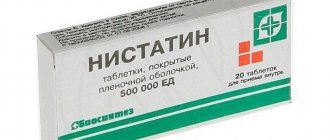Metronidazole
Gastrointestinal disorders: epigastric pain. nausea, vomiting. diarrhea, glossitis, stomatitis, “metallic” taste in the mouth, decreased appetite, anorexia, dry oral mucosa. constipation, pancreatitis (reversible cases), discoloration of the tongue, coated tongue" (due to the proliferation of fungal microflora).
Immune system disorders: angioedema, anaphylactic shock.
Nervous system disorders: peripheral sensory neuropathy, headache, convulsions, dizziness, the development of encephalopathy and subacute cerebellar syndrome (impaired coordination and synergism of movements, ataxia, dysarthria, gait disturbances, nystagmus, tremor) has been reported, which are reversible after discontinuation of metronidazole , aseptic meningitis.
Mental disorders: psychotic disorders, including confusion, hallucinations; depression, insomnia, irritability, increased excitability.
Visual disturbances: transient visual disturbances such as diplopia, myopia, blurred contours of objects, decreased visual acuity, impaired color perception: neuropathy/optic neuritis.
Blood and lymphatic system disorders: agranulocytosis, leukopenia, neutropenia, thrombocytopenia.
Disorders of the liver and biliary tract: increased activity of liver enzymes (aspartate aminotransferase, alanine aminotransferase, alkaline phosphatase), development of cholestatic or mixed hepatitis and hepatocellular liver damage, sometimes accompanied by jaundice; In patients treated with metronidazole in combination with other antibacterial agents, cases of liver failure requiring liver transplantation were observed.
Skin and subcutaneous tissue disorders: rash, itching, skin flushing, urticaria, pustular skin rash, Stevens-Johnson syndrome. toxic epidermal necrolysis.
Disorders of the kidneys and urinary tract: staining of urine in a brownish-reddish color, caused by the presence of a water-soluble metabolite of metronidazole in the urine, dysuria, polyuria. cystitis, urinary incontinence, candidiasis.
General disorders and disorders at the injection site: fever, nasal congestion, arthralgia, weakness.
Laboratory and instrumental data: flattening of the T wave on the electrocardiogram.
Instructions for use METRONIDAZOLE tablets
To avoid the development of resistance of microorganisms, metronidazole should only be used to treat infections caused by metronidazole-sensitive strains (according to microbiological examination of the material or epidemiological data).
Trichomoniasis with clinical symptoms.
Metronidazole is indicated for the treatment of trichomoniasis with clinical symptoms in women and men, if the presence of trichomonas has been confirmed by appropriate laboratory tests (smear and/or culture).
Asymptomatic trichomoniasis.
Metronidazole is indicated for the treatment of women with asymptomatic trichomoniasis (endocervicitis, cervicitis or cervical erosion). Because there is evidence that the presence of trichomonas may interfere with the accurate evaluation of cytological smears, additional smears should be performed after eradication of the parasite.
Treatment of a spouse without clinical manifestations.
T. vaginalis infection is a sexually transmitted disease. Thus, asymptomatic sexual partners should be treated at the same time to prevent reinfection from the partner, even if the pathogen is not isolated. The decision about whether to treat an asymptomatic male partner in whom trichomonas is not detected, or where testing has not been performed, is an individual one. In making this decision, it should be noted that there is evidence that a woman can become infected again if her husband is not treated. In addition, because there are significant difficulties in isolating the pathogen from an asymptomatic patient, negative smear and culture results should not be relied upon. In any case, in case of re-infection, the spouses should be treated with metronidazole at the same time.
Amoebiasis.
Metronidazole is indicated for the treatment of acute intestinal amebiasis (amebic dysentery) and liver abscess caused by amoebae. When treating a liver abscess caused by amoebas with metronidazole, the need for aspiration or drainage of pus cannot be excluded.
Anaerobic bacterial infections.
Metronidazole is indicated for the treatment of severe infections caused by susceptible anaerobic bacteria. Necessary surgical procedures must be performed in combination with metronidazole therapy. In case of mixed aerobic and anaerobic infection, appropriate antimicrobial agents should be used in addition to metronidazole. When treating severe anaerobic infections, metronidazole is usually given first. Intra-abdominal infections, including peritonitis, intra-abdominal abscess and liver abscess, are caused by Bacteroides, including the B. fragilis group (B. fragilis, B. distasonis, B. ovatus, B. thetaiotaomicron, B. vulgatus), Clostridium, Eubacterium, Peptococcus niger and Peptostreptococcus .
Infections of the skin and skin structures,
caused by Bacteroides (including the B. fragilis group), Clostridium, Peptococcus niger, Peptostreptococcus and Fusobacterium.
Gynecological infections,
including endometritis, endomyometritis, tubo-ovarian abscess and infections after gynecological surgery caused by Bacteroides (including B. fragilis group), Clostridium, Peptococcus niger and Peptostreptococcus.
Bacterial septicemia,
caused by Bacteroides (including the B. fragilis group) and Clostridium.
Bone and joint infections
caused by Bacteroides species (including the B. fragilis group) as adjunctive therapy.
CNS infections
including meningitis and brain abscess caused by Bacteroides (including B. fragilis group).
Lower respiratory tract infections,
including pneumonia, empyema and lung abscess caused by Bacteroides (including B. fragilis group).
Endocarditis,
caused by Bacteroides (including the B. fragilis group).
Metronidazole tablets 250 mg No. 10x3
Name
Metronidazole tablets 250 mg, 30 pcs.
Description
The tablets are white with a yellowish-greenish tint, flat-cylindrical, scored on one side and chamfered.
Main active ingredient
Metronidazole.
Release form
Pills.
Dosage
250 mg.
pharmachologic effect
Synthetic antibacterial and antiprotozoal drug of the 5-nitroimidazole group. The drug has an antibacterial and antiprotozoal effect. Suppresses the development of protozoa (Trichomonas vaginalis, Entamoeba histolytica, Gardnerella vaginalis, Giardia intestinalis, Lamblia spp.), highly effective against obligate anaerobic bacteria Bacteroides spp. (including Bacteroides fragilis, Bacteroides distasonis, Bacteroides ovatus, Bacteroides thetaiotaomicron, Bacteroides vulgatus), Fusobacterium spp., Veillonella spp., Prevotella (Prevotella bivia, Prevotella buccae, Prevotella disiens) and some gram-positive microorganisms (Eubacter spp., Clostridium spp., Peptococcus spp., Peptostreptococcus spp.). In combination with amoxicillin, it is active against Helicobacter pylori (amoxicillin suppresses the development of resistance to metronidazole). Has no direct effect on aerobes and facultative anaerobes. For mixed aerobic-anaerobic infections, metronidazole acts synergistically with antibiotics effective against pathogenic aerobes. Increases the sensitivity of tumors to radiation, causes disulfiram-like reactions, and stimulates reparative processes.
Indications for use
To avoid the development of resistance of microorganisms, metronidazole should only be used to treat infections caused by metronidazole-sensitive strains (according to microbiological examination of the material or epidemiological data). Trichomoniasis with clinical symptoms. Metronidazole is indicated for the treatment of trichomoniasis with clinical symptoms in women and men, if the presence of trichomonas has been confirmed by appropriate laboratory tests (smear and/or culture). Asymptomatic trichomoniasis. Metronidazole is indicated for the treatment of women with asymptomatic trichomoniasis (endocervicitis, cervicitis or cervical erosion). Because there is evidence that the presence of trichomonas may interfere with the accurate evaluation of cytological smears, additional smears should be performed after eradication of the parasite. Treatment of a spouse without clinical manifestations. T. vaginalis infection is a sexually transmitted disease. Thus, asymptomatic sexual partners should be treated at the same time to prevent reinfection from the partner, even if the pathogen is not isolated. The decision about whether to treat an asymptomatic male partner in whom trichomonas is not detected, or where testing has not been performed, is an individual one. In making this decision, it should be noted that there is evidence that a woman can become infected again if her husband is not treated. In addition, because there are significant difficulties in isolating the pathogen from an asymptomatic patient, negative smear and culture results should not be relied upon. In any case, in case of re-infection, the spouses should be treated with metronidazole at the same time. Amoebiasis. Metronidazole is indicated for the treatment of acute intestinal amebiasis (amebic dysentery) and liver abscess caused by amoebae. When treating a liver abscess caused by amoebas with metronidazole, the need for aspiration or drainage of pus cannot be excluded. Anaerobic bacterial infections. Metronidazole is indicated for the treatment of severe infections caused by susceptible anaerobic bacteria. Necessary surgical procedures must be performed in combination with metronidazole therapy. In case of mixed aerobic and anaerobic infection, appropriate antimicrobial agents should be used in addition to metronidazole. When treating severe anaerobic infections, metronidazole is usually given first. Intra-abdominal infections, including peritonitis, intra-abdominal abscess and liver abscess, are caused by Bacteroides, including the B. fragilis group (B. fragilis, B. distasonis, B. ovatus, B. thetaiotaomicron, B. vulgatus), Clostridium, Eubacterium, Peptococcus niger and Peptostreptococcus . Infections of the skin and skin structures caused by Bacteroides (including the B. fragilis group), Clostridium, Peptococcus niger, Peptostreptococcus and Fusobacterium. Gynecological infections, including endometritis, endomyometritis, tubo-ovarian abscess and infections after gynecological surgery caused by Bacteroides (including the B. fragilis group), Clostridium, Peptococcus niger and Peptostreptococcus. Bacterial septicemia caused by Bacteroides (including the B. fragilis group) and Clostridium. Bone and joint infections caused by Bacteroides species (including the B. fragilis group) as adjunctive therapy. Central nervous system infections, including meningitis and brain abscess, caused by Bacteroides (including the B. fragilis group). Lower respiratory tract infections, including pneumonia, empyema and lung abscess caused by Bacteroides (including the B. fragilis group). Endocarditis caused by Bacteroides (including the B. fragilis group).
Directions for use and doses
Take orally, during or after meals, without chewing. Trichomoniasis in women and men. The course of treatment is chosen individually. One-day course of treatment – 2 grams (8 tablets) as a single dose or divided into two doses of 1 gram (4 tablets) 2 times a day. One-day treatment is indicated in cases where there is a suspicion that the patient cannot strictly adhere to the treatment regimen. A seven-day course of treatment is 250 mg (1 tablet) three times a day for 7 days. Cure rates may be higher after a seven-day course of treatment. Pregnant women should not take metronidazole during the first trimester of pregnancy. Carrying out a one-day course of therapy for pregnant women is contraindicated, since it leads to a high concentration of metronidazole in the blood plasma and the drug can penetrate into the fetus. When repeating courses of treatment with metronidazole, it is recommended to take a break of 4-6 weeks. Before and after these courses, it is necessary to perform a blood test for the total number of leukocytes and leukocyte formula. Amoebiasis. Adults: for intestinal amebiasis, 750 mg orally three times a day for 5–10 days; for liver abscess, 500 mg or 750 mg three times a day for 5 to 10 days. Children: daily dose of 35–50 mg/kg, divided into three oral doses for 10 days. For the treatment of severe anaerobic bacterial infections. Metronidazole is prescribed initially. The usual adult dose is 7.5 mg/kg PO every six hours (about 500 mg for a 70 kg patient). The maximum daily dose is 4 g. Duration of therapy is from 7 to 10 days (treatment of infections of bones and joints, lower respiratory tract and endocardium may be longer). In elderly patients, the pharmacodynamics of metronidazole may be altered; monitoring of metronidazole levels in the blood serum is necessary to select the dose. In patients with severe liver disease, accumulation of metronidazole is possible and its dose should be reduced. Close monitoring of metronidazole plasma levels and signs of toxicity is recommended.
Use during pregnancy and lactation
During the first trimester of pregnancy, metronidazole is contraindicated. In the second and third trimesters of pregnancy, the drug should be used with caution, if absolutely necessary, with a proper assessment of the benefits of therapy for the mother and the potential risk to the fetus. Metronidazole passes into breast milk. When prescribing the drug to nursing mothers, breastfeeding should be stopped.
Impact on the ability to drive vehicles and other potentially dangerous mechanisms
Dizziness, confusion, hallucinations, or seizures may occur with this drug, which may interfere with operator activity.
Precautionary measures
During the treatment period, ethanol intake is contraindicated (the development of disulfiram-like reactions is possible: spastic abdominal pain, nausea, vomiting, headache, sudden “flushes” of blood to the face). Patients should abstain from drinking alcohol for at least 48 hours after stopping metronidazole therapy. When treating trichomonas vaginitis in women and trichomonas urethritis in men, it is necessary to abstain from sexual activity. Simultaneous treatment of sexual partners is mandatory. Treatment does not stop during menstruation. After treatment for trichomoniasis, control tests should be carried out during 3 consecutive cycles before and after menstruation. During treatment with metronidazole, symptoms of candidal infection may appear. Due to insufficient data regarding the risk of mutagenicity in humans, the decision to prescribe long-term use of metronidazole must be carefully considered. Use with caution in patients with porphyria. It is recommended to carry out regular clinical and laboratory monitoring if treatment continues for more than 10 days. With long-term therapy, it is necessary to monitor the peripheral blood picture. With leukopenia, the possibility of continuing treatment depends on the risk of developing an infectious process. Caution should be exercised in patients with epilepsy or a history of seizures, since the use of metronidazole in high doses may provoke seizures in such individuals. With long-term treatment, the risk of developing peripheral neuropathy should be taken into account. The appearance of ataxia, dizziness and any other deterioration in the neurological status of patients requires cessation of treatment. In persons with impaired renal function, the half-life of metronidazole does not change and no adjustment is required in the regimen of its use, despite the fact that metronidazole metabolites may be retained in the body in such patients. During hemodialysis, metronidazole is completely removed within 8 hours, so after the dialysis procedure you should immediately take another dose of metronidazole. There is no need to change the dosage regimen of metronidazole in patients who are on intermittent or continuous peritoneal dialysis. In patients with liver failure and encephalopathy, the administration of metronidazole may lead to aggravation of the symptoms of encephalopathy due to metabolic disorders, so caution should be exercised when prescribing metronidazole to this category of patients. Metronidazole can immobilize treponemes and lead to a false-positive Nelson test. Metronidazole can affect the determination of such biochemical indicators as aspartate aminotransferase (AST), alanine aminotransferase (ALT), lactate dehydrogenase (LDH), triglycerides, glucose. Metronidazole turns urine dark.
Interaction with other drugs
Strengthens the effect of indirect anticoagulants, which leads to an increase in the time of prothrombin formation (requires dose adjustment of anticoagulants). The simultaneous administration of drugs that stimulate microsomal oxidation enzymes in the liver (phenobarbital, phenytoin) can accelerate the elimination of metronidazole, resulting in a decrease in its plasma concentration. Cimetidine inhibits the metabolism of metronidazole, which may lead to an increase in its concentration in the blood serum and an increased risk of side effects. Concomitant use with disulfiram can lead to the development of various neurological symptoms (the interval between prescriptions is at least 2 weeks). When taken simultaneously with lithium preparations, the concentration of the latter in plasma may increase and the development of symptoms of intoxication (you should stop taking lithium preparations or reduce the dose). It is not recommended to combine with non-depolarizing muscle relaxants (vecuronium bromide). Sulfonamides enhance the antimicrobial effect of metronidazole. The simultaneous use of alcohol and metronidazole causes disulfiram-like reactions (cramp-like abdominal pain, nausea, vomiting, headache, skin flushing). Metronidazole reduces the clearance of 5-fluorouracil; their combined use may lead to increased toxicity of 5-fluorouracil. Patients receiving cyclosporine concomitantly with metronidazole are at risk for elevated cyclosporine serum levels. If coadministration is necessary, serum cyclosporine and creatinine levels should be carefully monitored. Taking metronidazole may increase plasma levels of busulfan and contribute to increased busulfan toxicity.
Contraindications
Hypersensitivity, leukopenia (including history), organic lesions of the central nervous system (including epilepsy), liver failure (in case of high doses), pregnancy (first trimester), lactation period, children under 6 years of age. Carefully. Pregnancy (II–III trimesters), renal/liver failure.
Compound
Each tablet contains: active ingredient: metronidazole – 250.0 mg; excipients: microcrystalline cellulose, calcium stearate, potato starch.
Overdose
Symptoms: nausea, vomiting, anorexia, convulsions. Treatment: gastric lavage, administration of activated carbon, symptomatic therapy. There is no specific antidote; it is eliminated from the body during hemodialysis. Peritoneal dialysis is ineffective.
Side effect
The frequency of side effects is given in the following gradation: very often (≥ 1/10); often (≥ 1/100,
Storage conditions
In a place protected from moisture and light at a temperature not exceeding 25 °C. Keep out of the reach of children.
Buy Metronidazole tablets 250 mg No. 10x3 in the pharmacy
Price for Metronidazole tablets 250 mg No. 10x3
Instructions for use for Metronidazole tablets 250 mg No. 10x3








